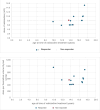A Belgian single centre outcome study of radioiodine treatment in adolescents with Graves' disease
- PMID: 39730594
- PMCID: PMC11680922
- DOI: 10.1038/s41598-024-82052-z
A Belgian single centre outcome study of radioiodine treatment in adolescents with Graves' disease
Abstract
Up to 80% of children/adolescents with Graves' disease (GD) may require second-line treatment with either surgery or radioactive iodine (RAI) therapy after treatment with antithyroid drugs. These interventions aim to induce permanent hypothyroidism, but are not always successful. We aimed to evaluate the initial success rate (within the first year) of RAI treatment and its determining factors as second-line treatment in teenagers with GD. We also assessed the tolerability of RAI therapy and the onset speed of RAI-induced hypothyroidism. We conducted a retrospective chart review of children < 18 years treated with RAI (scaled fixed dose) for GD between January 2007 and December 2022 at the UZ Brussels. Fourteen teenagers treated with RAI were identified. Their ages at time of treatment ranged from 9.8 to 17.3 years, with administered I131 doses between 5.8 and 15.0mCi (median 7.9mCi). All but two patients responded within six months. Thyroxine treatment was started between 4 and 14 weeks (median 9 weeks) after RAI therapy. The time to thyroxine substitution correlated positively with age (Rho = 0.498; p = 0.099) and total I131-dose (Rho = 0.582; p = 0.047). One patient experienced transient RAI induced sialadenitis. None of the patients relapsed during a follow-up period of 1.2 to 13 years. A cure rate of 86% was observed in GD teenagers receiving a second-line RAI treatment, with no major complications. Most patients became hypothyroid within three months, underscoring the importance of early thyroid function monitoring.
Keywords: Children; Graves’ disease; Hyperthyroidism; Paediatric; Radioiodine ablation.
© 2024. The Author(s).
Conflict of interest statement
Declarations. Competing interests: The authors declare no competing interests.
Figures
Similar articles
-
Radioactive iodine therapy for pediatric Graves' disease: a single-center experience over a 10-year period.J Pediatr Endocrinol Metab. 2020 Mar 26;33(3):383-389. doi: 10.1515/jpem-2019-0316. J Pediatr Endocrinol Metab. 2020. PMID: 31603857
-
The effect of propylthiouracil on subsequent radioactive iodine therapy in Graves' disease.Clin Endocrinol (Oxf). 1997 Oct;47(4):425-30. doi: 10.1046/j.1365-2265.1997.2741075.x. Clin Endocrinol (Oxf). 1997. PMID: 9404440
-
Long-term follow-up study of radioiodine treatment of hyperthyroidism.Clin Endocrinol (Oxf). 2004 Nov;61(5):641-8. doi: 10.1111/j.1365-2265.2004.02152.x. Clin Endocrinol (Oxf). 2004. PMID: 15521969
-
The tale of radioiodine and Graves' orbitopathy.Thyroid. 2010 Jul;20(7):785-93. doi: 10.1089/thy.2010.1640. Thyroid. 2010. PMID: 20578895 Review.
-
Post-radioiodine De Novo Onset Graves' Ophthalmopathy: Case Reports and a Review of the Literature.Semin Ophthalmol. 2015 May;30(3):227-31. doi: 10.3109/08820538.2013.839801. Epub 2014 Jan 10. Semin Ophthalmol. 2015. PMID: 24409943 Review.
Cited by
-
The Impact of Radioiodine (131I) Therapy of Thyroid Disease on Salivary Glands Function and Inflammation: A Comprehensive Review.Biomedicines. 2025 Jun 7;13(6):1404. doi: 10.3390/biomedicines13061404. Biomedicines. 2025. PMID: 40564122 Free PMC article. Review.
References
-
- Ma, C., Kuang, A., Xie, J. & Liu, G. Radioiodine treatment for pediatric Graves’ disease. Cochrane Database Syst. Rev.3, CD006294 (2008). - PubMed
-
- Marques, O., Antunes, A. & Oliveira, M. J. Treatment of Graves’ disease in children: The Portuguese experience. Endocrinol. Diabetes Nutr. (Engl Ed). 65 (3), 143–149 (2018). - PubMed
-
- Król, A., Czarniecka, A. & Jarząb, B. Definitive treatment of Graves’ disease in children and adolescents. Endokrynol Pol.72 (6), 661–665 (2021). - PubMed
-
- Cohen, R. Z., Felner, E. I., Heiss, K. F., Wyly, J. B. & Muir, A. B. Outcomes analysis of radioactive iodine and total thyroidectomy for pediatric Graves’ disease. J. Pediatr. Endocrinol. Metab.29 (3), 319–325 (2016). - PubMed
-
- Cemeroglu, A. P., Kleis, L., Wood, M. A. & Davis, A. T. Reliability of early iodine 123 uptake for treatment of Graves disease in children. Endocr. Pract.17 (4), 541–545 (2011). - PubMed
MeSH terms
Substances
Grants and funding
LinkOut - more resources
Full Text Sources


